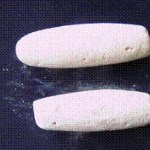arsenic
It's been interesting to watch as microbiology's own cold fusion debate has been raging. It began with an extraordinary claim about bacteria using arsenate as a replacement when phosphate concentrations are low (1).
It progressed when at least two scientist / bloggers ( here, and here) (not bloggers! the horrror! how uncivil!) gave public "journal club" presentations on blogs (envision dripping slime).
It continued with the science journalists lamenting about having swallowed the hype.
And it seemingly ended with another scientist / blogger's post that seemed to equate discussions…
As a dedicated chemistry nut - I mean, of course, enthusiast - I've recently wondered if my favorite science could explain the existence of zombies.
And after mulling it over - helped along by the suggestion of Scibling Scicurious that a Zombie Day would be a good idea and also by a number of cocktails from the home speakeasy, I believe I've come up with a very reasonable theory.
1. The poisonous element arsenic (As) is famed for its ability to make a dead person look, well, undead.
2. Why? Arsenic helps preserve soft tissues, partly by interfering with the ability of bacteria…
The name Phar Lap comes from an Asian word for lightning; a sky flash. A passing dazzle of light, a spark in the night.
And so he was, the big copper racehorse, born in New Zealand, trained in Australia, whose dazzling speed made him one of those unexpected beacons of hope during the Great Depression and who, according to a report published in an international chemistry journal in April, was killed by a massive dose of arsenic.
Of course, no one who follows race horse history could be entirely surprised by that finding. For one thing, it built on preliminary results from 2006. But from the…
During the 1970s, international aid agencies came up with a brilliant plan to stem a plague of water-borne illnesses in the Asian country of Bangladesh. They would underwrite the installation of wells in disease-troubled villages, tapping into the cleaner ground water below.
They would use simple, relatively inexpensive tube wells, place thousands of these over-sized drinking straws into the shallow aquifers. And these straws - millions of them - would suck up the cleaner, microorganism free water in healthy abundance.
At first, it seemed to work like a blessing. Infant mortality…
Once upon a time - by which I mean the 19th century - people spilled the poison arsenic into their lives with free and merry hands.
Arsenic was mixed into medicines, into cosmetics, into weed killers, insecticies, rat poisons, fly papers. It was the primary ingredient in a number of well-known dyes used to color fabric, wallpaper, the artificial leaves used to decorate hats and wreaths, cardboard boxes, greeting cards, labels, candles, India rubber balls, oil paint, tin plants, Venetian blinds, carpets, soap, and even green stones set into costume jewelry.
Naturally, poisoners…
On July 4, 1850, U.S. President Zachary Taylor attended an Independence Day celebration where he ate well - snacking on fresh cherries and creamy milk, sampling a variety of treats pressed on him by enthusiastic well-wishers. Five days later, Taylor was dead of a severe attack of gastroenteritis.
And for decades afterward, suspicions lingered that one of those so-called well-wishers had been an assassin, had mixed arsenic into a slice of pie or dish of ice cream. A high dose of the metallic poison arsenic can also bring on severe nausea and painful stomach cramps.
Finally, in 1991, one of…
One of the most repeated rules in toxicology is this: the dose makes the poison.
In other words, a milligram of arsenic is unlikely to kill you. Make that 200 milligrams and a cemetery plot awaits. Seems obvious, right? But what if we're talking about a benign substance - say a drink of cold water? And this is pure water, free of arsenic and any other toxic substance.
If the dose goes up in the same proportion - if instead of drinking a standard 8-ounce glass of water you gulp down 160 ounces - could it kill you? Absolutely yes.
People have been convicted of homicide in water poisoning cases…
Just before Christmas, the US FDA issued a warning regarding a clay-based traditional West African remedy for morning sickness called Nzu or Calabar or Calabash clay. We discussed this topic here when the initial health warning came out from Texas.
The problem with the product is that it contains high levels of lead and arsenic that could be toxic to both fetus and mother.
And now the problem has expanded beyond Texas.
Scott Gavura at his excellent Science-Based Pharmacy blog tweeted earlier that the New York City Department of Health issued a similar warning today:
February 16, 2010 - A…
Late last summer, six researchers at Harvard University's medical school fell into a poisoner's trap. Each poured a cup of coffee from a communal coffee maker in the school's pathology department. All of them ended up in the hospital; some had fainted, others were dizzy and nauseated, most couldn't hear over the ringing in their ears.
Investigators quickly discovered that the coffee machine's water tank had been laced with laboratory preservative called sodium azide, used to keep bacteria from growing in chemical solutions. This offered up an almost limitless pool of suspects - anyone…




